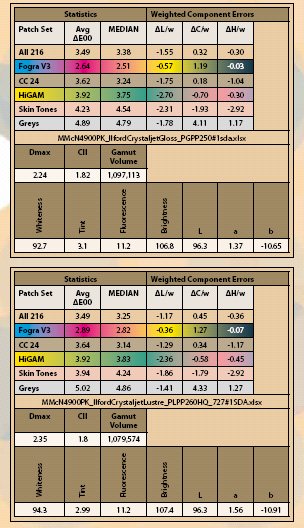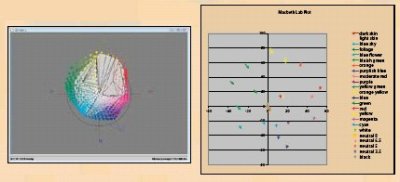articles/Paper/chaseharman-page1
Paper Chase Harman Crystaljet Elite Gloss and Luster - part 1 of 1 2
by Mike McNamee Published 01/04/2012

According to the Harman website this pair of papers are for "everyday use, but still capable of exhibition results."
For an 'everyday' paper it is a very creditable performer and no compromises are required other than the acceptance of a high OBA activity. These are very 'bright' papers which now occupy positions two and three in our database for
Fluorescence and Brightness respectively. At 10 Lab points blue they are as far down the b scale as we have ever gonewhen measuring base whites.
Such a high brightness creates prints with quite an impact although the skin tones are, as always, slightly compromised by the invasion of blue from the base paper.

Base Properties
The OBA activity dominates with the response in the blue part of the spectrum, lifted by around 10 percentage points.
The substrate is resin coated which creates a silver-halidelike appearance to the general sheen of the paper. The Luster is quite 'flat' with just a hint of surface structure, the gloss is a full one, without reaching the heights of the classic mirror-like Cibachrome of old. Both coatings seemed quite tough and scratch resistant and did not, for example, mark when prints were stacked. In the hand the prints have a certain weight from their resin-coated structure and they are perfectly flat with not the slightest hint of curl.
The whiteness data are tabled.
Colour Audit
Colour prints had lots of sparkle and good depth with Dmaxes of around 2.24 for the Luster and 2.35 for the Gloss.
The 'colour signature' of the audits was identical with equal values in the average errors of 3.49ΔE00. Overall the prints came in at around 1.4% too dark. Metamerism of the allcolour print was low at 1.8 (CII D65 to Tungsten A on 50% grey). The gamut volumes were high, over the 1 million mark. Shadow details were held down to 20 RGB points, the highlights preserved up to 252 points, both good results.
The HiGAM colours were good for the blues but slightly desaturated in other parts of the spectrum as the tones were mapped towards the blue white point. The HiGAM tones shifts were mimicked by the lower saturation Macbeth CC24 set (see Lab plot).
Overall the statistics are compromised by the coolness of the paper and the resulting prints looks a lot better than the numbers might suggest as the eye readily accommodates for the base tone.
Web profiles
Our colour audit was carried out using a bespoke profile on an Epson 4900 using i1 Publish and a 727-patch target. We also tried the Epson 4900 profile available on the Harman website. The results were ghastly with the average error rising to 16.4 and the maximum recorded error a staggering 55.6ΔE Lab. The profiles are poorly made and the gamut volumes measured from the profiles were 791,000 and 756,000, both woefully below the 1 million mark that the 4900 is capable of. No response was received to our technical enquiry.
You are currently on page 1
- Paper Chase Harman Crystaljet Elite Gloss and Luster page 1
- Paper Chase Harman Crystaljet Elite Gloss and Luster page 2
1st Published 01/04/2012
last update 09/12/2022 14:52:24
More Paper Articles
There are 0 days to get ready for The Society of Photographers Convention and Trade Show at The Novotel London West, Hammersmith ...
which starts on Wednesday 15th January 2025





